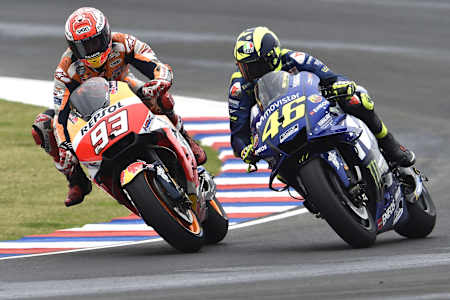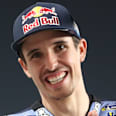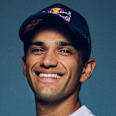
MotoGP
MotoGP replaced the previous premier class of the motorbike world championship in 2002. We look back at the history of MotoGP.
Since 2002, MotoGP has marked the pinnacle of two-wheeled motorsport for road bikes, but the origins of the motorbike world championship go back much further. Here's everything you need to know about the history of MotoGP.
01
Birth of the Motorcycle World Championship
The first mass-produced motorbike with a petrol engine dates back to 1894 and was named "Hildebrand & Wolfmüller". 13 years later, in 1907, the legendary Isle of Man TT was held, the world's first official motorbike race.
However, it took until 1949 for the FIM (Fédération Internationale de Motocyclisme) to organise a world championship for road motorbikes for the first time - the unofficial birth of MotoGP.
At that time, the riders competed in different cubic capacity classes. The championships were divided into 50 cc and 80 cc, 125 cc, 250 cc, 350 cc and 500 cc for solo machines, and 500 cc for motorbikes with sidecars. In the early days, it was mainly English and Italian brands with four-stroke engines that dominated.
The record holder is the Italian Giacomo "Ago" Agostini, born in 1942, who competed for the first time on 15 September 1963 at his home race in Monza, Italy. The rest is history: between 1963 and 1977, Agostini took 122 race wins (in 194 starts) and was crowned motorbike world champion 15 times.
What is the MotoGP anyway? Our 'ABC of' series sheds light on the background of the most important sports and provides exciting facts, including about the motorbike world championship.
02
The road to the foundation of MotoGP
In the following years and decades, there were again and again far-reaching rule changes within the motorbike world championship. In 1983, the 350cc class was abolished without replacement, and one year later the 50cc class was replaced by the 80cc class.
The classic race start, which at that time still involved pushing the racing machines, was also replaced by a standing start in the late 1980s.
In the 1990s, the 80 cc class and the sidecar races were also removed from the programme, and until 2001, only the 125 cc, 250 cc and 500 cc classes were raced.
At the same time, the so-called Superbike World Championship (SBK) was also established under the umbrella of the FIM, in which riders and teams competed with production-based motorbikes. It was originally launched by the four big Japanese manufacturers Honda, Yamaha, Kawasaki and Suzuki.
In the course of the 2001 season, the pressure of the Japanese manufacturers, above all Honda, on the governing body became so great that there was a far-reaching restructuring within the motorbike world championship. The established 500cc class was replaced in 2002 by MotoGP, which was supposed to make the World Championship fit for the new millennium.
The animated history of MotoGP: We take you on a slightly different journey through time.
03
The early years of MotoGP: The "Rossi" years
The new branding was also followed by new regulations. From now on, four-stroke engines with a maximum power of 990 cc were used in the top class of motorbike racing. In the final year of the original 500 cc motorbike world championship (2001), the "Doctor" Valentino Rossi was crowned world champion.
The early days of MotoGP were also to go to the Italian, who between 2002 and 2005 claimed a full four titles as rider's world champion, first on a Honda machine, then on Yamaha. Rossi leads the list of the best riders' world champions together with the Spaniard Marc Márquez - both riders have six world championship titles in MotoGP so far.
The smaller displacement classes (125 cc and 250 cc) continued to take place under the umbrella of the World Motorcycle Championship. They were only incorporated into the MotoGP calendar much later: Moto2 replaced the previous 250 cc class from the 2010 season, and Moto3 replaced the third-highest class two years later, i.e. for the 2012 season.
- MotoGP, Moto2 and Moto3: The individual classes in the fact check
Márquez picks up speed: Our film accompanies the Spaniard on his way back to MotoGP after his surgery and rehab.
04
MotoGP's path to the modern era
From the 2007 season, the maximum permissible engine capacity within MotoGP was limited to 800 cc. The FIM hoped that this would increase safety for the riders, as the speeds would be lower. In practice, however, this was hardly noticeable. In fact, the speed in the corners could even be increased, so that crashes occurred more frequently.
For the 2012 season, the displacement was then increased again. From this season onwards, the bikes were equipped with 1,000 cc displacement, and at the same time the maximum number of cylinders was limited to four. The dominance of the Spanish riders began: between 2012 and 2020, the title of riders' world champion went to Spain.
Honda's Marc Márquez has been crowned world champion six times (most recently in the 2019 season), Yamaha's Jorge Lorenzo has secured two more titles, while the crown went to Joan Mir in the 2020 season.
- Behind the scenes of MotoGP: Presenter Vanessa Guerra gives a look behind the scenes in the 'MotoGP Inside Pass'.
Since 2016, a minimum weight of 157 kg has applied within the technical regulations for a bike in the MotoGP class. The power of a motorbike, on the other hand, is not regulated and is only measured in lower limits for competitive reasons.
According to estimates, a current motorbike in MotoGP produces between 260 and 300 hp. This means that speeds of over 360 km/h are possible. The current record was set by Ducati rider Johann Zarco at the Losail International Circuit in Qatar. The two-time Moto2 world champion was clocked at an unbelievable 362.4 km/h in free practice - but the Frenchman's success was helped by slipstream and tailwind.
Time travel through the history of MotoGP: In our film 'Racing Together', some legends look back on an eventful history.
05
MotoGP 2023: An outlook
The 2022 MotoGP season has ended and celebrated a new world champion in Italian Francesco Bagnaia. The 2023 season starts on 26.03.2023 with the GP of Portugal in Portimao.
New in the coming season are the Kazakhstan Grand Prix on 09 July, as well as the Indian Grand Prix at the former Formula 1 circuit, the Buddh International Circuit in Noida, on 24 September.
With a whopping 21 races, the MotoGP calendar is more extensive than ever before. Brad Binder (#33) and Jack Miller (#43) will start for Red Bull KTM Factory Racing in 2023 and want to build on the great successes of the 2022 season.
GasGas replaces Tech3 as the satellite team. Pol Espargaró and Moto 2 newcomer Augusto Fernandez will start here.







